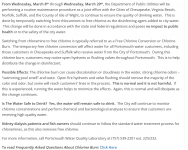- Feb 6, 2018
- 184
- Pool Size
- 21000
- Surface
- Vinyl
- Chlorine
- Salt Water Generator
- SWG Type
- Hayward Aqua Rite (T-15)
Apparently chloramine is used as our tap water disinfectant. Our water doesn't have much of a smell at all to it. Our city is doing maintenance that requires switching to free chlorine to perform a Chlorine Burn and said that the water will have a strong chlorine odor (see artlicle below). They did this 6 years ago and the water sure did have a very strong odor - especially when taking a shower! But shouldn't the smell issue be reversed? Shouldn't free chlorine have no smell and the normal chloramine be the one with the strong odor? Thanks!



